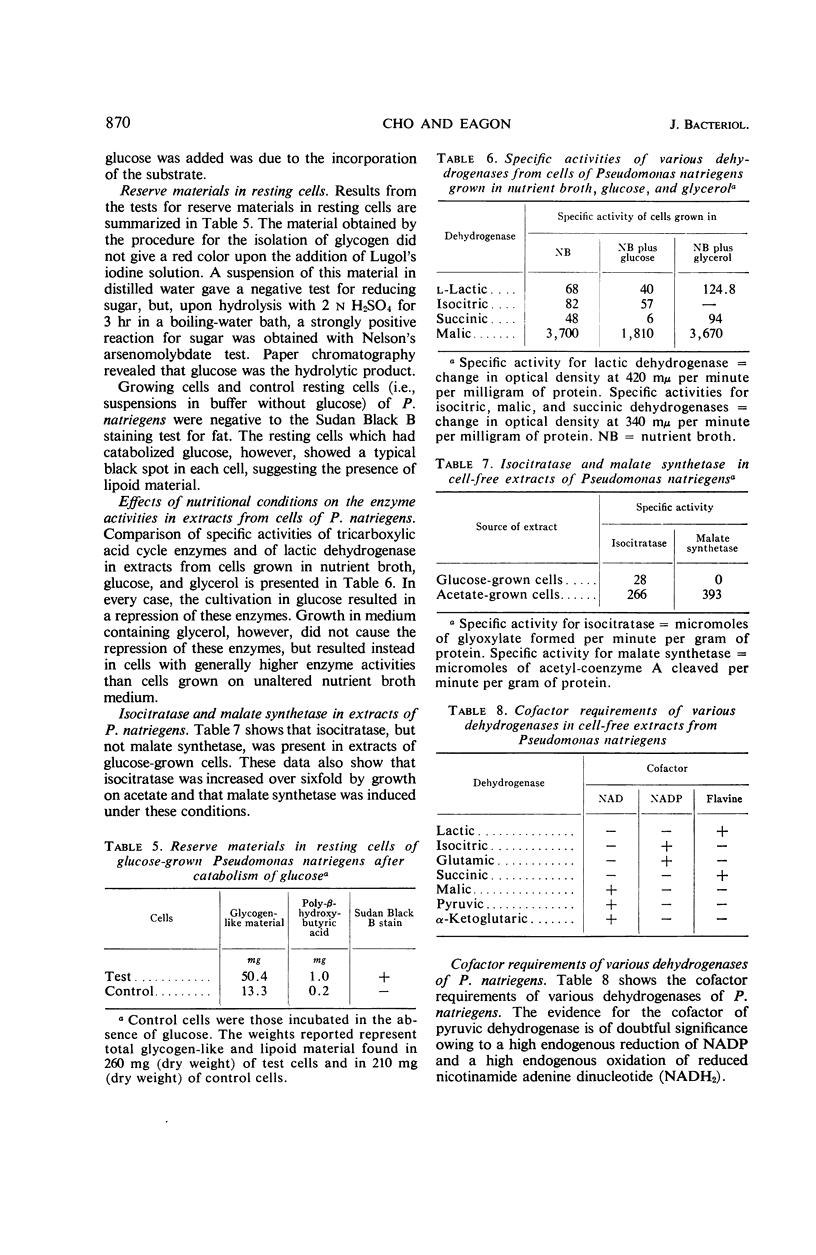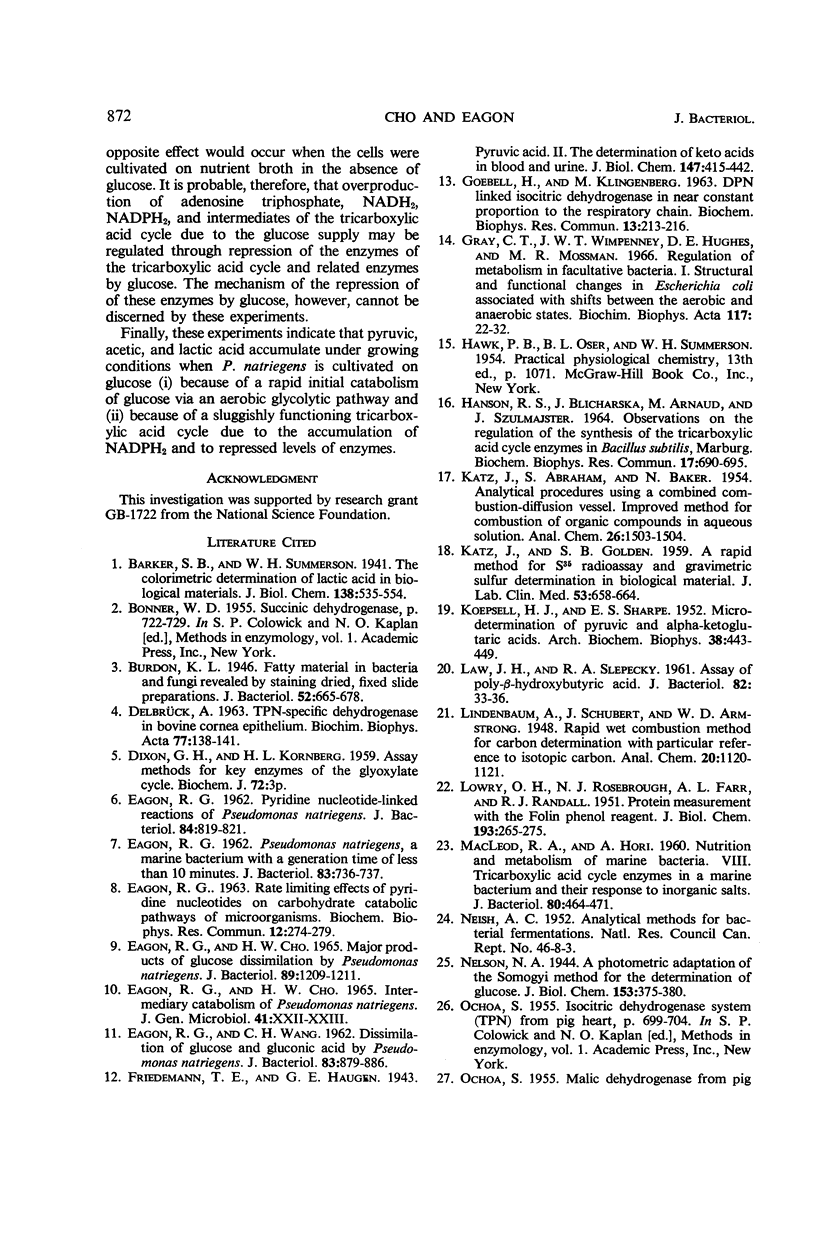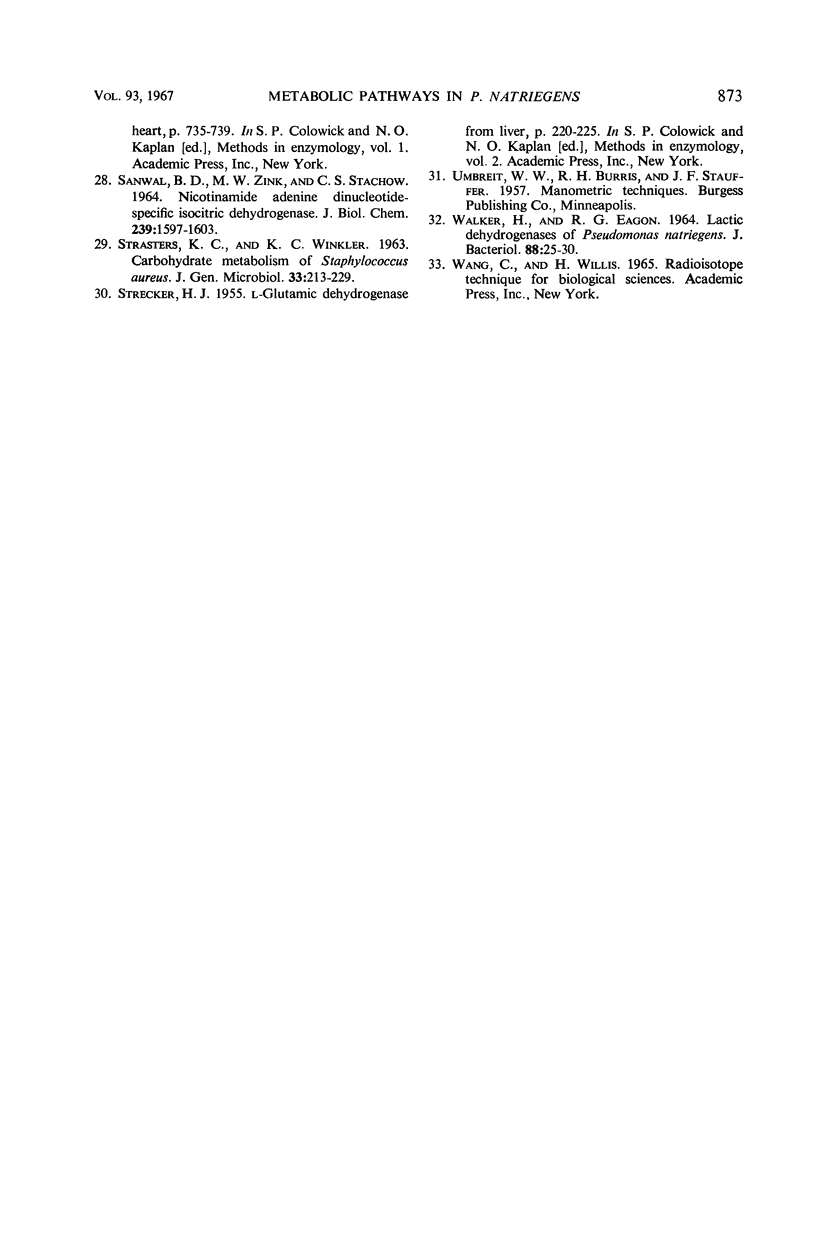Abstract
Less than 50% of theoretical oxygen uptake was observed when glucose was dissimilated by resting cells of Pseudomonas natriegens. Low oxygen uptakes were also observed when a variety of other substrates were dissimilated. When uniformly labeled glucose-14C was used as substrate, 56% of the label was shown to accumulate in these resting cells. This material consisted, in part, of a polysaccharide which, although it did not give typical glycogen reactions, yielded glucose after its hydrolysis. Resting cells previously cultivated on media containing glucose completely catabolized glucose and formed a large amount of pyruvate within 30 min. Resting cells cultivated in the absence of glucose catabolized glucose more slowly and produced little pyruvate. Pyruvate disappeared after further incubation. In this latter case, experimental results suggested (i) that pyruvate was converted to other acidic products (e.g., acetate and lactate) and (ii) that pyruvate was further catabolized via the tricarboxylic acid cycle. Growth on glucose repressed the level of key enzymes of the tricarboxylic acid cycle and of lactic dehydrogenase. Growth on glycerol stimulated the level of these enzymes. A low level of isocitratase, but not malate synthetase, was noted in extracts of glucose-grown cells. Isocitric dehydrogenase was shown to require nicotinamide adenine dinucleotide phosphate (NADP) as cofactor. Previous experiments have shown that reduced NADP (NADPH2) cannot be readily oxidized and that pyridine nucleotide transhydrogenase could not be detected in extracts. It was concluded that acetate, lactate, and pyruvate accumulate under growing conditions when P. natriegens is cultivated on glucose (i) because of a rapid initial catabolism of glucose via an aerobic glycolytic pathway and (ii) because of a sluggishly functioning tricarboxylic acid cycle due to the accumulation of NADPH2 and to repressed levels of key enzymes.
Full text
PDF







Selected References
These references are in PubMed. This may not be the complete list of references from this article.
- Burdon K. L. Fatty Material in Bacteria and Fungi Revealed by Staining Dried, Fixed Slide Preparations. J Bacteriol. 1946 Dec;52(6):665–678. doi: 10.1128/jb.52.6.665-678.1946. [DOI] [PMC free article] [PubMed] [Google Scholar]
- DELBRUCK A. TPN-SPECIFIC ISOCITRATE DEHYDROGENASE IN BOVINE CORNEA EPITHELIUM. Biochim Biophys Acta. 1963 Sep 3;77:138–141. doi: 10.1016/0006-3002(63)90477-3. [DOI] [PubMed] [Google Scholar]
- EAGON R. G., CHO H. W. MAJOR PRODUCTS OF GLUCOSE DISSIMILATION BY PSEUDOMONAS NATRIEGENS. J Bacteriol. 1965 May;89:1209–1211. doi: 10.1128/jb.89.5.1209-1211.1965. [DOI] [PMC free article] [PubMed] [Google Scholar]
- EAGON R. G. Pseudomonas natriegens, a marine bacterium with a generation time of less than 10 minutes. J Bacteriol. 1962 Apr;83:736–737. doi: 10.1128/jb.83.4.736-737.1962. [DOI] [PMC free article] [PubMed] [Google Scholar]
- EAGON R. G. RATE LIMITING EFFECTS OF PYRIDINE NUCLEOTIDES ON CARBOHYDRATE CATABOLIC PATHWAYS OF MICROORGANISMS. Biochem Biophys Res Commun. 1963 Aug 1;12:274–279. doi: 10.1016/0006-291x(63)90295-x. [DOI] [PubMed] [Google Scholar]
- EAGON R. G., WANG C. H. Dissimilation of glucose and gluconic acid by Pseudomonas natriegens. J Bacteriol. 1962 Apr;83:879–886. doi: 10.1128/jb.83.4.879-886.1962. [DOI] [PMC free article] [PubMed] [Google Scholar]
- Eagon R. G. PYRIDINE NUCLEOTIDE-LINKED REACTIONS OF PSEUDOMONAS NATRIEGENS. J Bacteriol. 1962 Oct;84(4):819–821. doi: 10.1128/jb.84.4.819-821.1962. [DOI] [PMC free article] [PubMed] [Google Scholar]
- Gray C. T., Wimpenny J. W., Hughes D. E., Mossman M. R. Regulation of metabolism in facultative bacteria. I. Structural and functional changes in Escherichia coli associated with shifts between the aerobic and anaerobic states. Biochim Biophys Acta. 1966 Mar 28;117(1):22–32. doi: 10.1016/0304-4165(66)90148-6. [DOI] [PubMed] [Google Scholar]
- HANSON H. M., WITOSLAWSKI J. J., CAMPBELL E. H. REVERSIBLE DISRUPTION OF A WAVELENGTH DISCRIMINATION IN PIGEONS FOLLOWING ADMINISTRATION OF PHENIPRAZINE. Toxicol Appl Pharmacol. 1964 Nov;6:690–695. doi: 10.1016/0041-008x(64)90119-x. [DOI] [PubMed] [Google Scholar]
- KATZ J., GOLDEN S. B. A rapid method for S35 radioassay and gravimetric sulfur determination in biologic material. J Lab Clin Med. 1959 Apr;53(4):658–664. [PubMed] [Google Scholar]
- KOEPSELL H. J., SHARPE E. S. Micro-determination of pyruvic and alpha-keto-glutaric acids. Arch Biochem Biophys. 1952 Jul;38:443–449. doi: 10.1016/0003-9861(52)90050-7. [DOI] [PubMed] [Google Scholar]
- LAW J. H., SLEPECKY R. A. Assay of poly-beta-hydroxybutyric acid. J Bacteriol. 1961 Jul;82:33–36. doi: 10.1128/jb.82.1.33-36.1961. [DOI] [PMC free article] [PubMed] [Google Scholar]
- LOWRY O. H., ROSEBROUGH N. J., FARR A. L., RANDALL R. J. Protein measurement with the Folin phenol reagent. J Biol Chem. 1951 Nov;193(1):265–275. [PubMed] [Google Scholar]
- MACLEOD R. A., HORI A. Nutrition and metabolism of marine bacteria. VIII. Tricarboxylic acid cycle enzymes in a marine bacterium and their response to inorganic salts. J Bacteriol. 1960 Oct;80:464–471. doi: 10.1128/jb.80.4.464-471.1960. [DOI] [PMC free article] [PubMed] [Google Scholar]
- SANWAL B. D., ZINK M. W., STACHOW C. S. NICOTINAMIDE ADENINE DINUCLEOTIDE-SPECIFIC ISOCITRIC DEHYDROGENASE. A POSSIBLE REGULATORY PROTEIN. J Biol Chem. 1964 May;239:1597–1603. [PubMed] [Google Scholar]
- STRASTERS K. C., WINKLER K. C. CARBOHYDRATE METABOLISM OF STAPHYLOCOCCUS AUREUS. J Gen Microbiol. 1963 Nov;33:213–229. doi: 10.1099/00221287-33-2-213. [DOI] [PubMed] [Google Scholar]
- WALKER H., EAGON R. G. LACTIC DEHYDROGENASES OF PSEUDOMONAS NATRIEGENS. J Bacteriol. 1964 Jul;88:25–30. doi: 10.1128/jb.88.1.25-30.1964. [DOI] [PMC free article] [PubMed] [Google Scholar]


